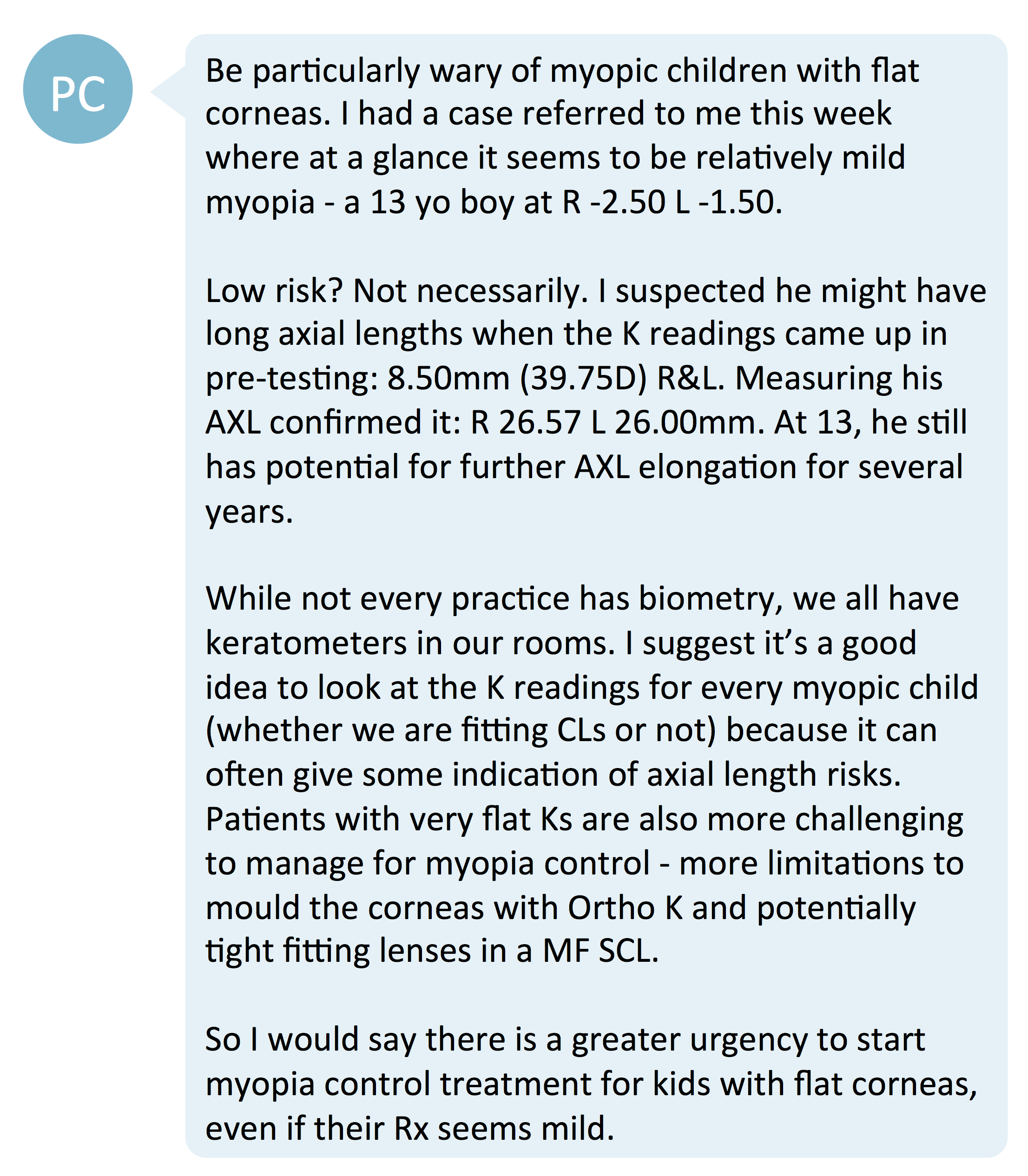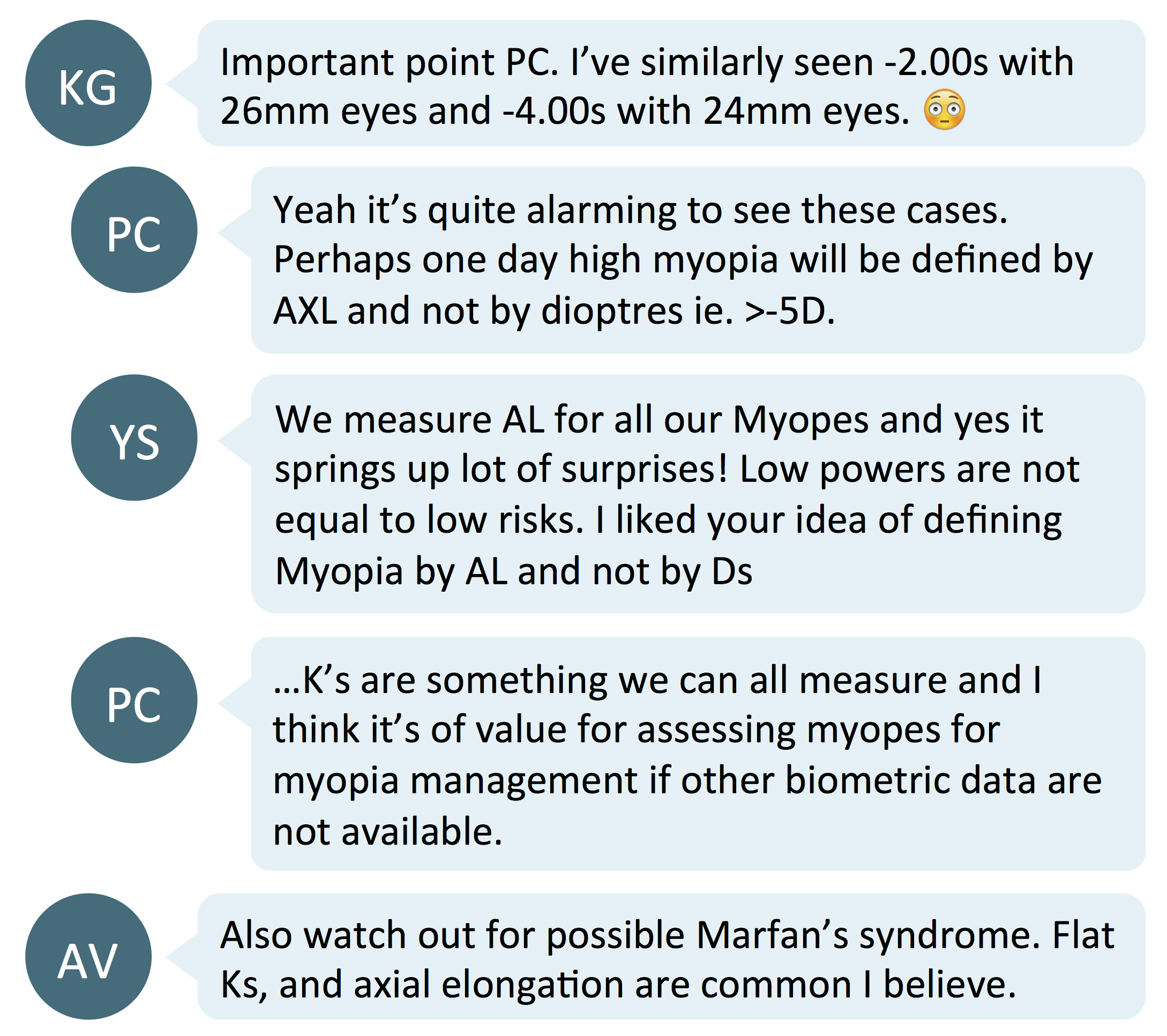Do you measure keratometry or corneal topography routinely in your practice? Measuring the cornea in myopes is useful when it comes to contact lens fitting, but can also fill in the puzzle pieces of the clinical picture. PC shared this interesting case about child with flat corneas. Note that in the post below, 'AXL' refers to axial length measurement, and 'K readings' refer to corneal curvature measurements.

Flat corneas and axial length
During the early emmetropization process, the cornea flattens as axial length increases.1 Then, during myopia progression in school-aged children, the corneal curvature tends to be stable while axial length increases.2 Therefore, when a patient has a flat cornea with mild or moderate myopia, it may be quite likely that the flat corneas mask the excessive growth of axial length. As the risk for ocular diseases in progressive myopia is largely linked to longer axial length,3 patients with flat corneas and low-to-moderate myopia are likely to be at a higher risk than one may think.

Whilst not every eye care practitioner has access to axial length measurements, it is far more likely that they would have access to K readings. Hence, paying attention to patients with flat K readings can alert us to the greater need and urgency for myopia management. One commenter also pointed out that flat K readings can mask longer axial length in Marfan Syndrome, where these patients may not always present with high myopia as expected.4
Flat corneas and orthokeratology

As the mechanics of orthokeratology (OK) lenses involve flattening the central cornea, one commenter asked if OK would be ruled out due to flat corneal curvature. One case report of two children with high myopia and the flat meridian of corneal curvature being around 8.3mm (40.5D) presented successful outcomes.5 These sorts of cases, though, are likely to be easier for the more experienced OK practitioner, as steeper corneal curvature and other corneal parameters such as eccentricity are important to predict treatment capacity.6
Take home messages:
- Be on alert when examining a myope with flat corneal curvature. These patients are likely to be a higher risk of myopia-related ocular health issues than expected from looking at their refraction alone.
- If you cannot measure axial length yourself, consider working with colleague eye care professionals with this instrumentation to obtain axial length data. This helps to quantify ocular health risk and can support strategizing myopia management.
Further reading

About Connie
Connie Gan is a clinical optometrist from Kedah, Malaysia, who provides comprehensive vision care for children and runs the myopia management service in her clinical practice.

About Kimberley
Kimberley Ngu is a clinical optometrist from Perth, Australia, with experience in patient education programs, having practiced in both Australia and Singapore.
This content is brought to you thanks to an unrestricted educational grant from

References
- Grosvenor T, Goss DA. Role of the cornea in emmetropia and myopia. Optom Vis Sci. 1998 Feb;75(2):132-45. (link)
- Mutti DO, Mitchell GL, Sinnott LT, et al. Corneal and crystalline lens dimensions before and after myopia onset. Optom Vis Sci. 2012;89(3):251-262. (link)
- Tideman JW, Snabel MC, Tedja MS, Van Rijn GA, Wong KT, Kuijpers RW, Vingerling JR, Hofman A, Buitendijk GH, Keunen JE, Boon CJ. Association of axial length with risk of uncorrectable visual impairment for Europeans with myopia. JAMA Ophthalmol. 2016 Dec 1;134(12):1355-63. (link)
- Konradsen TR, Zetterström C. A descriptive study of ocular characteristics in Marfan syndrome. Acta ophthalmologica. 2013 Dec;91(8):751-5. (link)
- Leong F, Cho P. Case series: Orthokeratology on flat cornea. Optom Vis Sci 2010:Abstract 105868. (link)
- Chan B, Cho P, Mountford J. Relationship between corneal topographical changes and subjective myopic reduction in overnight orthokeratology: a retrospective study. Clin Exp Optom. 2010 Jul;93(4):237-42. (link)











